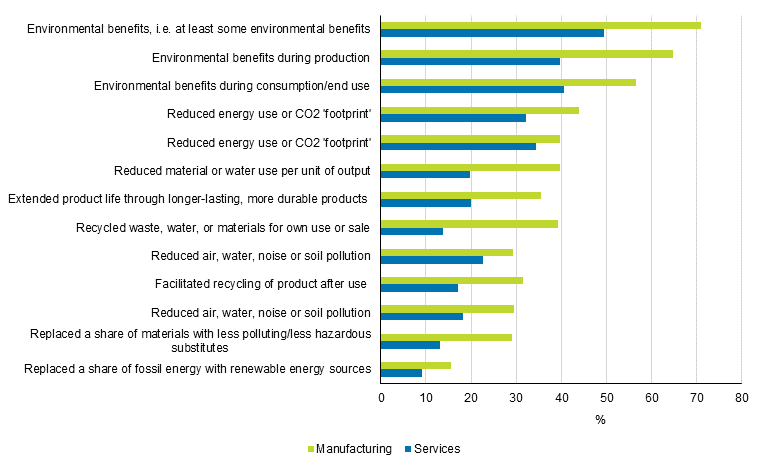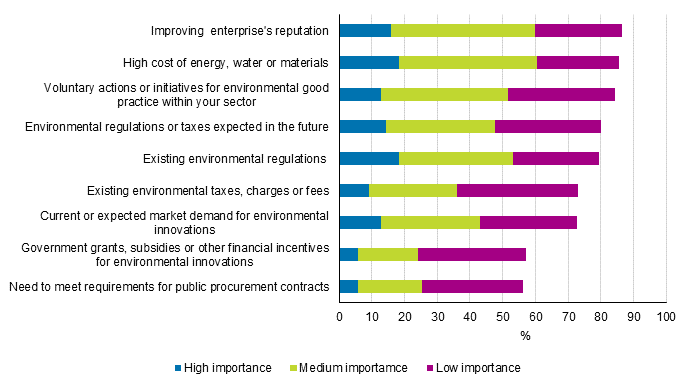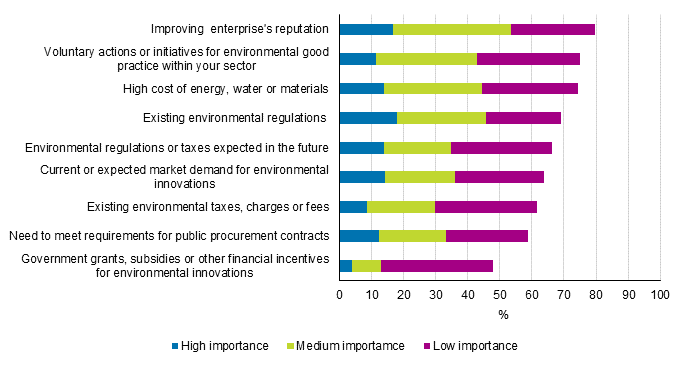9. Adoption of innovations producing environmental benefits in 2012 to 2014
An innovation producing environmental benefits is defined as a new or significantly improved product (good or service), process, organisational method or marketing method that creates environmental benefits compared to alternatives. The environmental benefits can be the primary objective of the innovation or a by-product of other objectives. The environmental benefits of an innovation can occur during the production of a good or service, or during its consumption or use by the end user of a product. The end user can be an individual, another enterprise, or the public sector.
Altogether, 60 per cent of enterprises reported adoption of innovations that had produced environmental benefits. This was 32 per cent of all enterprises. Fifty-two per cent of innovators reported environmental benefits during production and 48 per cent reported environmental benefits from consumption and end product use.
Manufacturing enterprises reported innovation-related environmental benefits more often than service industry enterprises, as the share in manufacturing was 71 per cent of innovations and 50 per cent in service industries.
The most common environmental benefit experienced in innovations was more efficient energy consumption during production and consumption and a smaller carbon footprint. The second most common environmental benefits detected during production were more efficient use of materials or water, recycling for own use or sales and lower pollution levels.Figure 35. Environmental benefits produced by innovations in manufacturing and services in 2012 to 2014, share of enterprises with innovations

Nearly one-fifth of enterprises that adopted environmental innovations felt that current environmental regulations were important for the enterprise's decision to adopt innovations that produce environmental benefits. Also, for example, improving the enterprise's reputation or high energy, water or material costs are central reasons for adopting innovations that produce environmental benefits. In contrast, of the provided options, the factors that least affected the adoption of environmental innovations were public financing, grants or some other financial incentive and responding to the requirements of public procurement contracts.
Figure 36. Factors influencing the introduction of innovations with environmental benefits by degree of importance in manufacturing in 2012 to 2014, share of enterprises with innovations with environmental benefits

Figure 37. Factors influencing the introduction of innovations with environmental benefits by degree of importance in services in 2012 to 2014, share of enterprises with innovations with environmental benefits

Source: Innovation 2014, Statistics Finland
Inquiries: Mervi Niemi 029 551 3263, Heidi Pirkola 029 551 3246, tiede.teknologia@stat.fi
Director in charge: Mari Yl�-Jarkko
Updated 2.6.2016
Official Statistics of Finland (OSF):
Innovation [e-publication].
ISSN=1797-4399. 2014,
9. Adoption of innovations producing environmental benefits in 2012 to 2014
. Helsinki: Statistics Finland [referred: 10.12.2025].
Access method: http://stat.fi/til/inn/2014/inn_2014_2016-06-02_kat_009_en.html

